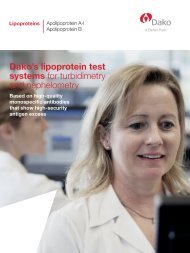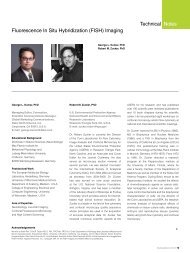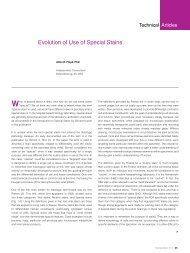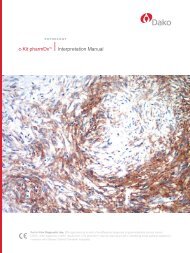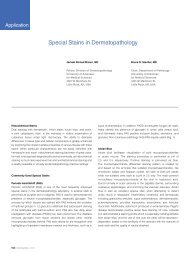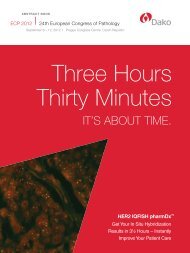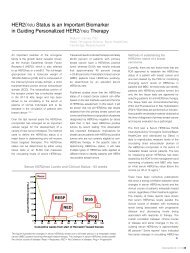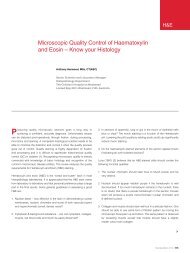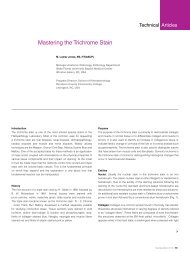Construction and Quality Assurance - Dako
Construction and Quality Assurance - Dako
Construction and Quality Assurance - Dako
Create successful ePaper yourself
Turn your PDF publications into a flip-book with our unique Google optimized e-Paper software.
Chapter 7 Tissue Microarray —<strong>Construction</strong> <strong>and</strong> <strong>Quality</strong> <strong>Assurance</strong>Rashmil Saxena BFA, HT(ASCP) CM <strong>and</strong> Sunil Badve MD, FRCPathRecent times have seen the advent of high throughput assays such asarray comparative genomic hybridization <strong>and</strong> cDNA microarray, whichhave lead to the rapid discovery of thous<strong>and</strong>s of potential biomarkers.However, these need to be validated in tissue-based studies in largedatasets to prove their potential utility. As these datasets are typicallypresent in the form of formalin fixed paraffin-embedded tissue blocks,immunohistochemical (IHC) methods are ideal for validation. However,performing whole-section IHC on hundreds to thous<strong>and</strong>s of blocksrequires lot of resources in terms of reagents <strong>and</strong> time. In addition, anaverage block will yield less than 300 slides of 5 µm each. The tissuemicroarray (TMA) technique circumvents some of these problems.The origin of TMAs can be attributed to Dr Hector Battifora’s humble“sausage” blocks (1) in which a number of tissues, typically fromdifferent organs, where thrown together in the same block <strong>and</strong> tissuedistribution of a particular antigen/protein was assessed. A significantdisadvantage of this technique was that when tumors or tissues fromthe same site were put together it was difficult if not impossible totrace them back to the patient. This prevented meaningful analysisof prognostic markers. However, many laboratories small <strong>and</strong> large(including our own) adopted this technology to generate multi-tissueor multi-organ tissue blocks. The next step in the development ofTMA was described by Wan et al. (2) who used a 16-gauge needleto manually bore cores from tissue blocks <strong>and</strong> array them in a multitissuestraw in a recognizable pattern. This method was furthermodified by Kononen et al. (3) using a 4 mm skin biopsy punch.They used a cast of a small amount of melted paraffin to record theposition of each punch specimen. This l<strong>and</strong>mark study lead to thedevelopment of a TMA precision microarray instrument with an x-yguide by Beecher Instruments, Sun Prairie, WI. This enabled realhigh-throughput analysis with arraying of up to 1000 cores in thesame block.Donor 1 Donor 2 Donor 3 Donor 4 Donor 5 Donor 6Recipientresearchta 22vegf (biog)I.U.ihc labFigure 1a. Principle of tissue microarray (TMA) analysis. Cylindrical cores areobtained from a number (up to 1,000) of individual formalin-fixed, paraffinembeddedtissue blocks. These are transferred to recipient TMA. Each TMAblock can be sectioned up to 300 times. All resulting TMA slides have the sametissues in the same coordinate positions. The individual slides can be used for avariety of analyses saving labor <strong>and</strong> reagent costs while maintaining uniformityof assay.Figure 1b. Typically a minimum of 3 cores for each case are used for 0.6 mm cores.IHC Staining Methods, Fifth Edition | 43
Tissue Microarray — <strong>Construction</strong> <strong>and</strong> <strong>Quality</strong> <strong>Assurance</strong>Consecutive case array: This type of array is constructed usingconsecutive cases belonging to a single tissue site. These types ofarrays are extremely useful for quality control purposes includingidentifying shifts <strong>and</strong> drifts in reagent quality. They are also useful instudying the prevalence of a protein/antigen in a given tumor type <strong>and</strong>analyzing the relationships between different biomarkers.Tumor characteristic-based array: This is a special type constructedsolely on the basis of a given characteristic such as patient age ortumor grade. The latter is useful for evaluating the frequency of amarker throughout the spectrum of tumor differentiation. SimilarlyTMAs can be generated based on the expression of a biomarkersuch as estrogen receptor or HER2/neu positive or triple negativebreast cancers. These types of biomarkers are useful in analyzinginterrelationships between different cellular pathways.Progression arrays: These types of arrays are used to analyze therole of protein(s) in cancer progression <strong>and</strong> consist of normal tissuesfrom patients without cancer, normal tissue from patients with cancer,pre-invasive lesions <strong>and</strong> tumor (from local <strong>and</strong> metastatic sites). Theaddition of normal tissue from close to the tumor <strong>and</strong> those muchfurther away from the tumor site might enable study of “field effect”.Outcome based arrays: These are the most valuable <strong>and</strong> mostdifficult to generate as they involve collation of tissues from patientsthat have the same disease <strong>and</strong> have been more or less similarlytreated <strong>and</strong> followed up for a significant period of time. The periodof follow-up depends on the type of disease or tumor being studied.These types of arrays are mostly used to evaluate prognostic orpredictive biomarkers. The presence of biomarkers in tumor subtypesmight then be used to design novel therapeutic strategies.Other special types: TMAs can be generated based on specificquestion being asked whether it be race (Caucasians versus AfricanAmericans), sex (male versus female) or more tissue orientedquestions such as center of the tumor versus invasive edge ofthe tumor.Team Required for TMA <strong>Construction</strong><strong>Construction</strong> of TMA is a team effort. The first <strong>and</strong> foremost questionthat needs to be answered is why is the TMA being constructed?This will decide the composition of the team. For the generationof the simplest of TMA, a technologist might be all that is required.However, most TMA synthesis will require close collaboration withthe pathologist, who will identify the areas of interest <strong>and</strong> mark themfor the technologists to obtain cores. It is a good idea to involvebiostatisticians from the onset rather than just asking them to dothe data analysis. They can help with deciding the number of coresfrom each case, total number of cases needed, how they should bedistributed across the array to avoid bias. In general the number ofcases required in a TMA is dependent on the size of the differenceexpected in the outcome <strong>and</strong> the degree of variance in the samples;this sample size calculation is best done with the assistanceof a statistician. Outcome based TMAs may need input from orparticipation of treating physicians/oncologists.Steps Involved in TMA <strong>Construction</strong>The following steps are recommended for breast TMA construction:Step 1. Define the questionAs described above TMAs are created to answer specific questions. Itis important to clearly define this question at the outset. The questionwill help define the number of cases <strong>and</strong> cores that need to be used inthe generation of the TMA. For example a TMA containing 20 casesmight be sufficient for routine quality control/ assessment but is notenough for biomarker assessment.Step 2. Review the cases to be included in the TMAPull all the cases to be included in the TMA together. If the blockshave been previously cut into for other clinical or research purposes,a fresh H&E slide may be obtained to ensure that the slide isrepresentative of the block. Review all the slides <strong>and</strong> mark areas ofinterest. It is useful to mark multiple areas from more than one block,as blocks may be depleted or misplaced. Areas to be sampled (tumor,normal, <strong>and</strong> pre-malignant tissues) should be identified.IHC Staining Methods, Fifth Edition | 45
Tissue Microarray — <strong>Construction</strong> <strong>and</strong> <strong>Quality</strong> <strong>Assurance</strong>Step 3. TMA core size <strong>and</strong> number of coresSize of the cores: The typical core sizes used for TMA constructsare 0.6 mm, 1 mm, 1.5 mm <strong>and</strong> 2 mm. Many workers consider thesmall 0.6 mm cores as the st<strong>and</strong>ard of practice. Use of smaller corediameters, however, allows for a greater number of cores to beextracted from the lesion <strong>and</strong> a greater number of cores that can fitinto the TMA block. In addition, they tend to inflict little damage onthe donor <strong>and</strong> recipient blocks <strong>and</strong> the cores are easier to remove<strong>and</strong> replace from these blocks.The larger core sizes have the advantages of being more robust<strong>and</strong> the cores are more difficult to damage during h<strong>and</strong>ling.However, these larger sizes can lead to increased likelihood ofdifficulty in extracting the cores from the blocks as well as greaterchance of the blocks being broken or cracked during the TMAgeneration process.Number of cores: The optimal number of cores, to be included in theTMA, is marker dependent <strong>and</strong> can vary depending on the degree oftumor heterogeneity. In general, the greater the degree of intratumoralheterogeneity for any given marker, the greater the number of coresthat will be required. When using 0.6 mm sized cores, it is typicalto use a minimum of 3 cores per case. Three 0.6 mm cores are stillbetter than one 1.0 mm core, even though the tissue surface area isessentially identical. Three 1.0 mm cores could result in destructionof the donor block; so tumor size would also drive number/size ofcores to be taken. Studies that have used 1 mm core punches havetended to use two cores (5).Density: The maximum number of cores that should be placed ona single block will vary depending on core size, block size, <strong>and</strong> IHCmethodology, among other factors. It is best to avoid placing so manycores on a TMA that the surface section of cores becomes largerthan the antibody coverage area on the slide programmed by theAutostainer (<strong>Dako</strong> A/S). Similarly, it diminished the amount of paraffinat the edge of the block creating difficulties in sectioning. Coresshould start at least 3 mm away from the block edges, to preventthe paraffin from cracking. Max number of cores per block shouldtherefore depend on the comfort level of the technician as well asthe pathologist, who is ultimately going to read the slides. For thesereason, it is typical for most workers to put somewhere between 100<strong>and</strong> 300 of 0.6 mm cores in a TMA block.Distance: The distance between cores should NOT exceed thecore diameter. It is easier for the microscopist to follow the rows <strong>and</strong>columns if he/she can “lead” from one core to another. If the distancebetween cores is large, it difficult to follow the chain of cores <strong>and</strong>may result in skipping of lanes <strong>and</strong> false recording of data whenperforming manual interpretation.Step 4. Identify control tissues to be included in the blockControls should be placed on each TMA block, for quality control<strong>and</strong> to address tumor heterogeneity. Three types of control tissuesmay be used:A. Tissue-specific controls: Normal tissues <strong>and</strong> cell lines fromthe organ site can help in comparative analysis of the markerexpression status in addition to help ensure st<strong>and</strong>ardization.B. Biology-associated controls: It is useful to insert pathwayassociated controls to ensure that the reagents are workingwell. These serve as good internal controls within the TMA block.Common examples include endometrium for hormone receptor,testes or lymph node or tonsils for proliferation.C. Organ system controls: adrenal gl<strong>and</strong>, brain, breast, colon,kidney, liver, lung, pancreas, placenta, prostate, testes, salivarygl<strong>and</strong>, uterine myometrium (smooth muscle). These are particularlyuseful when the TMA is being used to analyze novel markers, asone or more of these tissues can serve as internal controls. Normaltissue, at a minimum, should contain: liver, kidney, endometrium,lymph node, colon, <strong>and</strong> testis.Step 5. Make a TMA map depicting the layoutThe TMA map may consist of a simple Excel sheet or may be a moresophisticated datasheet made using one of the TMA generationprograms. This will serve as a guideline to in order arrange blocks<strong>and</strong> sequence in which they need to be arrayed. Thus the TMA mapwill contain the exact location of each case, including the duplicatesamples, <strong>and</strong> controls are located. Mini-arrays (“City Blocks”) of thecores (3x5, 4x5, 5x5, 6x5) can be spaced for easy orientation, withcontrol tissue in the rows between the mini-arrays.46 | IHC Staining Methods, Fifth Edition
Tissue Microarray — <strong>Construction</strong> <strong>and</strong> <strong>Quality</strong> <strong>Assurance</strong>Figure 3. TMA Map <strong>and</strong> block design: TMA layout should be asymmetric <strong>and</strong> irregular so that it is relatively easy to orient the TMA block. This irregularity should beobvious to the histo-technician who is cutting the block so that all the cuts from the block are taken on the slides in an identical manner. In addition, locating the controlsin an asymmetric manner is also helpful when reading the slides. For example, the following features may be included:1. Blank rows <strong>and</strong> columns that do not run down the center lines of the TMA blocks but to one side so that the block is cut into two-third <strong>and</strong> one-third grids.2. A blank corner for orientation or a tail coming out from close to one of the corners.3. Asymmetric distribution of control cell lines <strong>and</strong> tissue controls. Placing stained cores of “control” tissues at the edge of the grid can be usefulto mark orientation.IHC Staining Methods, Fifth Edition | 47
Tissue Microarray — <strong>Construction</strong> <strong>and</strong> <strong>Quality</strong> <strong>Assurance</strong>Issues related to layout:1. TMA layout should be asymmetric <strong>and</strong> irregular (see figure 3).2. If multiple TMA blocks are being made from the same project, oneconsideration is to carry a small proportion of cases onto otherblocks (e.g., 10%).3. Cores from the same case: Ideally, if same-patient cores are to beplaced on the same block, they should be dispersed on the block.This will decrease the risk of interpretation bias. However, someworkers prefer this arrangement so that they can immediately“normalize” or “confirm” the results between the cores from thesame patient. If same-patient cores are to be dispersed acrossmultiple blocks, it is better to place them in different regions of thearray (outer <strong>and</strong> inner) (outer in one block <strong>and</strong> inner in the other),with r<strong>and</strong>om placement, rather than placing them in the samelocation in each block.Step 6. Creating the TMA itselfInstrumentation: The need for specialized instrumentation forcreating TMAs is entirely based on the number of cores <strong>and</strong> value ofthe tissue being inserted in these TMAs. For TMAs being constructedfor quality control/quality assessment or work-up of new reagents, thenumber of cores being inserted is relatively low. This enables use oflarger cores <strong>and</strong> diminishes the need for specialized instrumentation.However, for TMAs to be made from valuable cases with scantmaterials, it is necessary to use these instruments. The simplest ofthese consist of h<strong>and</strong>-held punches <strong>and</strong> are generally not very usefulfor a serious TMA project, where it is necessary to use at least anintermediate grade device. These intermediate grade devices consistof a st<strong>and</strong> in addition to a positioning apparatus <strong>and</strong> ensure verticalpunching of the blocks <strong>and</strong> proper placement within the grid. Fullyautomated devices additionally have integrated computers that canbe programmed to select the donor sites from different blocks <strong>and</strong>transfer them in the recipient block.Donor block: The block from which a core will be taken is referredto as the donor block. The area of the donor block to be cored forTMA should be selected by a pathologist. Although it is intuitive, itmust be stated that the donor blocks should be optimally processed<strong>and</strong> should not contain any poorly processed areas. Similarly, coresshould be obtained from the block before the block gets depleted.The thicker the donor blocks the more the number of useful sectionscan obtained from the TMA. Core punches should be pushed gentlyinto the TMA block, <strong>and</strong> not too deeply as this can damage theneedle as well as the block. When using semi-automated devicesit is easier to mark the depth of the punch to the level of the plasticof the cassette.Recipient block: The block in which the cores are placed is referredto as the recipient block. It is best to place the cores towards thecenter of this block in order to prevent cracking of the block. After thecores are inserted, place the TMA in 37 °C overnight, <strong>and</strong> then onthe cold plate of the tissue embedding station with subsequent two tothree 1-hour cycles of hot/cold to temper the array. Multiple sectionsfrom the block should be cut at the same time to prevent wastage oftissue. Incomplete sections should not be discarded; these can beused for st<strong>and</strong>ardization of staining technique (see below).Staining TMAs: When performing staining of the TMA, the step is toensure that the staining procedure actually works in the laboratory <strong>and</strong>the procedure has been st<strong>and</strong>ardized. If the TMA has been obtainedfrom an outside institution, it is useful to get the tissue processed inthat laboratory or poor-quality sections from the TMA for practice <strong>and</strong>st<strong>and</strong>ardization; following st<strong>and</strong>ardization good quality TMA sectionsshould be used for analysis. As TMA sections are usually larger, theymight require care to ensure that the entire section is covered withreagents otherwise uneven staining will be observed.48 | IHC Staining Methods, Fifth Edition
Tissue Microarray — <strong>Construction</strong> <strong>and</strong> <strong>Quality</strong> <strong>Assurance</strong>Step 7. Validation <strong>and</strong> quality assuranceMeasures for the TMA should include the following:Figure 4a. Low power photograph of TMA stain.Validation: The use of TMAs enables analysis of large data sets,however this does not by any means suggest that the data setis not skewed. This skewing may be the result of the institution’slocation (population distributions with regards to race, ethnicity,access to health care), type of practice (community hospital versusreferral center). These collectively might influence the tumor size,grade <strong>and</strong> subtype composition of the cases in the dataset. Suchabnormalities of the dataset need to be compensated; the involvementof a biostatistician from the start (i.e from case selection) helps toprevent the creation of biased TMAs. It is useful to perform commonbiomarker analysis on sections from the created TMA to confirmthe “normal” distribution of known parameters. Comparison of thisdata with prior clinical data (e.g. ER analysis) obtained from wholesection analysis is particularly useful to validate utility of the TMA.Alternatively the incidence of expression of a number of biomarkersin the TMA should be compared to that in published literature (usingwhole sections).<strong>Quality</strong> assurance measures: It is critical to perform <strong>and</strong> analyzeH&E sections from the TMA to confirm the presence of tissueof interest (usually tumor) in the TMA sections. In addition, H&Eshould be performed at regular interval (e.g. on every 25th slide) oncuts from the TMA blocks. The above tests should be reviewed bya pathologist.TMA AnalysisFigure 4b. High power photograph of TMA stain.One of the limitations of the TMA is that the tissues in the tumorcores have been processed at different types <strong>and</strong> often with differentprotocols. This will lead to optimal staining of some tumors but alsosub-optimal staining (over or under-staining) of quite a few tumorcores. However, the large number of cases included in the TMA canto some extent compensate for the tissue heterogeneity.The analysis of the TMA has 2 components. The first involvesanalysis of the slides <strong>and</strong> recording of the data. The second involvesdata analysis.Slide analysis: The TMA slides can be analyzed manually;alternatively automated image analysis programs that can assist withthe analysis are also available. The need for these programs is basedon the work volume as well as density of the TMAs. Some programsgenerate a virtual slide of the TMA <strong>and</strong> further analysis can be doneusing a computer screen. This has the advantage of avoiding “burn’ tothe slides <strong>and</strong> all the cores can be analyzed at the same “optical <strong>and</strong>illumination” conditions. It additionally permits electronic storage ofIHC Staining Methods, Fifth Edition | 49
Tissue Microarray — <strong>Construction</strong> <strong>and</strong> <strong>Quality</strong> <strong>Assurance</strong>the fresh images <strong>and</strong> later re-analysis if required. This is particularlytrue for FISH sections which typically fade with time.Data AnalysisStep 1. Data cleaningGiven the large number of samples in a typical TMA study, analysisof the data can become quite a challenge. One needs to excludethe cases that are not informative; it is not unusual to lose up to 10%of cases due to insufficient representation of tissue of interest. Onthe informative cases, strategies for conversion of 3 values (oneper core) per each case into a single data point have to be devised.The commonly used strategies include using the highest value or anumerical mean of the values obtained (for review see Bentzen etal.) (6). Each method used for normalization has its own value aswell as limitation.References:1. Battifora H. The multitumor (sausage) tissue block: novel method forimmunohistochemical antibody testing. Lab Invest 1986;55:244-8.2. Wan WH, et al. A rapid <strong>and</strong> efficient method for testing immunohistochemicalreactivity of monoclonal antibodies against multiple tissuesamples simultaneously. J Immunol Methods 1987;103:121-9.3. Kononen, J., et al. Tissue microarrays for high-throughput molecularprofiling of tumor specimens. Nat Med 1998; 4:844-7.4. Chu P <strong>and</strong> Arber DA. Paraffin-section detection of CD10 in 505nonhematopoietic neoplasms. Frequent expression in renal cell carcinoma<strong>and</strong> endometrial stromal sarcoma. Am J Clin Pathol 2000;113: 374-82.5. Badve SS, et al. Estrogen- <strong>and</strong> progesterone-receptor status in ECOG2197: comparison of immunohistochemistry by local <strong>and</strong> centrallaboratories <strong>and</strong> quantitative reverse transcription polymerase chainreaction by central laboratory. J Clin Oncol 2008;26:2473-81.6. Bentzen SM, et al. Multiple biomarker tissue microarrays: bioinformatics<strong>and</strong> practical approaches. Cancer Metastasis Rev 2008; 27:481-94.7. Camp RL, et al. X-tile: a new bio-informatics tool for biomarker assessment<strong>and</strong> outcome-based cut-point optimization. Clin Cancer Res 2004;10:7252-9.8. McShane LM, et al. Reporting recommendations for tumor markerprognostic studies (REMARK). J Natl Cancer Inst 2005; 97: p. 1180-4.Step 2. Statistical analysisThe tests used to determine the p value will be dependent on the typeof data (i.e. nominal or categorical) as well as the degree of variancewithin the data. For simple analyses of relationships, contingencytables, <strong>and</strong> chi-squared tests are used. For demonstration of survivaldistributions, most researchers use the Kaplan-Meir plot <strong>and</strong> thenapply Log-rank analysis to test survival differences between groups.The most frequently used analytical strategy is to subdivide patientmaterial into high- <strong>and</strong> low-risk group based on the expression ofnovel biomarkers. Some commercially available computer programssuch as X-tile program (7) may assist the selection of best cut-offpoint. This cut-off point needs to be confirmed in a separate series ofcases to validate its utility. The NCI-EORTC group has developed theREMARK (Reporting recommendations for Tumor Marker prognosticstudies) (8) guidelines which should be followed whenever possible50 | IHC Staining Methods, Fifth Edition



